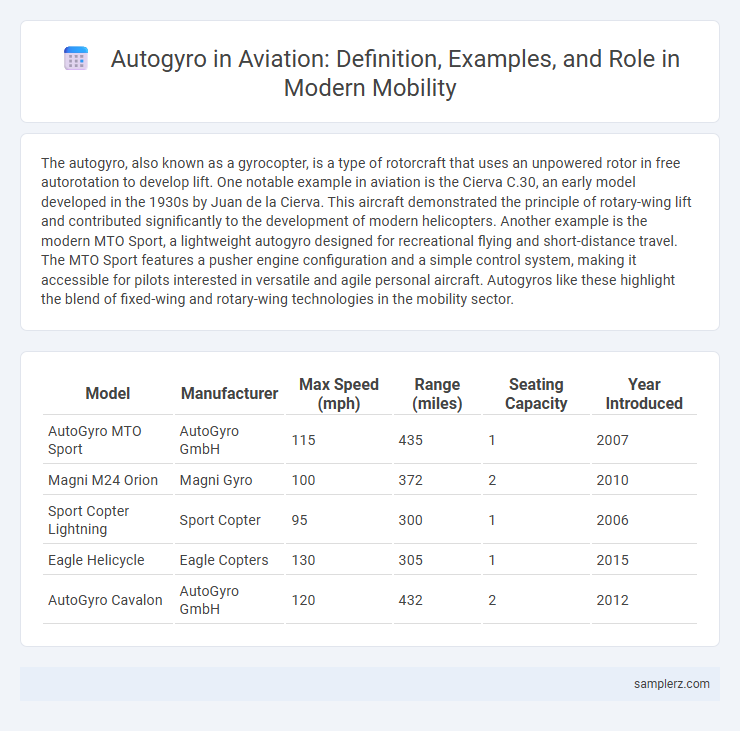The autogyro, also known as a gyrocopter, is a type of rotorcraft that uses an unpowered rotor in free autorotation to develop lift. One notable example in aviation is the Cierva C.30, an early model developed in the 1930s by Juan de la Cierva. This aircraft demonstrated the principle of rotary-wing lift and contributed significantly to the development of modern helicopters. Another example is the modern MTO Sport, a lightweight autogyro designed for recreational flying and short-distance travel. The MTO Sport features a pusher engine configuration and a simple control system, making it accessible for pilots interested in versatile and agile personal aircraft. Autogyros like these highlight the blend of fixed-wing and rotary-wing technologies in the mobility sector.
Table of Comparison
| Model | Manufacturer | Max Speed (mph) | Range (miles) | Seating Capacity | Year Introduced |
|---|---|---|---|---|---|
| AutoGyro MTO Sport | AutoGyro GmbH | 115 | 435 | 1 | 2007 |
| Magni M24 Orion | Magni Gyro | 100 | 372 | 2 | 2010 |
| Sport Copter Lightning | Sport Copter | 95 | 300 | 1 | 2006 |
| Eagle Helicycle | Eagle Copters | 130 | 305 | 1 | 2015 |
| AutoGyro Cavalon | AutoGyro GmbH | 120 | 432 | 2 | 2012 |
Introduction to Autogyros in Aviation
Autogyros, also known as gyrocopters, are rotary-wing aircraft that use an unpowered rotor in free autorotation to develop lift and a separate engine-powered propeller to provide thrust. These unique aircraft offer enhanced stability and short takeoff and landing capabilities, making them ideal for surveillance, reconnaissance, and personal mobility. Innovations in lightweight materials and avionics have expanded autogyro applications, improving efficiency and operational versatility in modern aviation.
Historical Development of Autogyros
The historical development of autogyros began in the early 1920s with Spanish engineer Juan de la Cierva's invention, aimed at solving the stall issues faced by fixed-wing aircraft. The Cierva C.4 marked a breakthrough by utilizing an unpowered rotor in autorotation to generate lift, allowing safer and slower flight. This innovation laid the groundwork for modern rotorcraft by combining airplane control systems with rotary-wing lift principles.
Key Features of Autogyro Design
Autogyros feature a freely rotating unpowered rotor that provides lift through autorotation, combined with a forward-thrusting engine-driven propeller for propulsion. Their unique design includes a short takeoff and landing capability, enhanced stability at low speeds, and the ability to operate safely in turbulent conditions. The lightweight, compact airframe paired with a rotor system devoid of complex gears or engines distinguishes autogyros from traditional helicopters and fixed-wing aircraft.
Famous Autogyro Models in History
The Cierva C.30, developed in the 1930s, stands as one of the most famous autogyro models, pioneering rotary-wing aviation with its innovative design and stable flight characteristics. Another iconic example is the Pitcairn PCA-2, extensively used in the United States for mail delivery and reconnaissance during the 1920s and 1930s, highlighting the autogyro's versatility in early aviation. The modern Magni M-16 exemplifies ongoing advancements, integrating lightweight materials and improved aerodynamics to enhance performance and safety in contemporary rotorcraft mobility.
Modern-Day Applications of Autogyros
Modern autogyros enhance urban air mobility with improved safety and efficiency in congested areas. Companies utilize autogyros for aerial surveying, agriculture monitoring, and recreational flying, benefiting from their stable flight and short takeoff capabilities. Recent advancements in lightweight materials and avionics have expanded autogyros' role in emergency medical services and law enforcement surveillance.
Military Use of Autogyros
Autogyros have been utilized in military aviation for reconnaissance, artillery spotting, and convoy escort missions due to their ability to operate from short or improvised airstrips. The Cierva C.30 and the Pitcairn PCA-2 exemplify early 20th-century autogyros employed by armed forces to enhance battlefield surveillance and communication. Modern military interest in autogyros persists for their low-speed maneuverability and reduced logistical footprint compared to helicopters.
Autogyros in Civilian and Recreational Flying
Autogyros in civilian and recreational flying offer a unique blend of safety, ease of operation, and short takeoff capabilities, making them popular among aviation enthusiasts. Their unpowered rotor provides stable lift, while a conventional engine-driven propeller delivers thrust, resulting in lower fuel consumption compared to helicopters. These aircraft excel in aerial photography, personal transport, and pilot training, contributing significantly to the diversity and accessibility of modern recreational aviation.
Comparison: Autogyros vs. Helicopters
Autogyros utilize an unpowered rotor that spins due to aerodynamic forces during forward motion, contrasting with helicopters which rely on powered rotors for vertical lift and hover capabilities. This design allows autogyros to be more mechanically simple, cost-effective, and safer in autorotation scenarios, but they lack the ability to hover and perform vertical takeoffs like helicopters. Flight stability in autogyros is often enhanced by forward speed, while helicopters maintain lift and stability even when stationary, making each ideal for different aviation roles.
Notable Autogyro Manufacturers
Notable autogyro manufacturers such as AutoGyro GmbH, founded in Germany, have pioneered the development of modern gyroplanes with advanced safety features and efficient rotary-wing designs. Magni Gyro in Italy is recognized for producing lightweight, agile autogyros used in recreational aviation and pilot training worldwide. Cavalon and MTOsport models by AutoGyro exemplify innovation with their enclosed cabins and powerful Rotax engines, enhancing flight stability and performance.
The Future Potential of Autogyros in Mobility
Autogyros offer promising advancements for urban air mobility with their exceptional short takeoff and landing capabilities, efficient fuel consumption, and enhanced safety features. Their ability to provide low-speed maneuverability and vertical versatility positions them as viable candidates for next-generation personal and cargo transport solutions. Integration with emerging electric propulsion technologies further amplifies their potential to revolutionize sustainable and flexible aviation mobility.

example of autogyro in aviation Infographic
 samplerz.com
samplerz.com